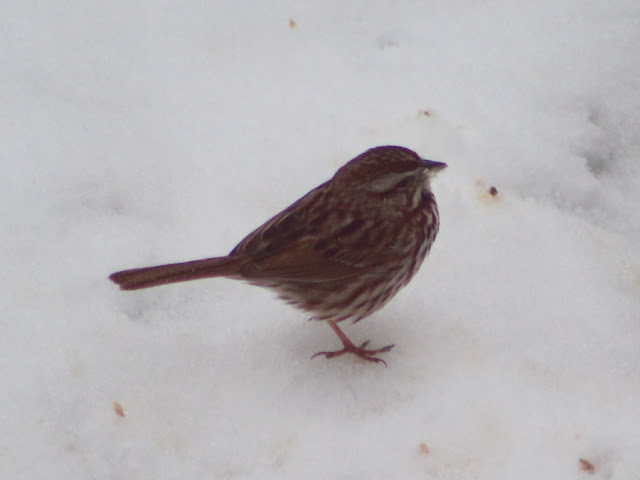 |
| The first waves in four months |
Ice out was declared on April 23rd, though there was no report from Marion Cove which is often the last cove to be free of ice, so it could have actually been a day or so later, but with no report from there, April 23rd is the official date. On the prior day, another observer saw the first loons on the lake. It's not known yet if they are the local residents or just passing through, but loon calls have been frequent since then. And within 24 hours of our return a host of spring activity proved life has returned to the lakes. First was a pair of beavers on their daily reconnaissance of the lake.
 |
| Back on the prowl |
And these busy rodents are already chewing their way through the shoreline forests.
 |
| A fresh beaver cut 40 yards from the lake |
The beaver were soon joined by a pair of buffleheads diving in the cove and the sound of osprey off in the distance. Then this morning the osprey made an appearance, loudly announcing their arrival with their distinctive cheep-cheep calls.
 |
| The osprey have returned from their own trip south to Central or South America |
There was a pair soaring overhead, circling around and occasionally landing in a tree.
This is not the behavior I typically see for osprey which are usually watching for fish from a branch hanging over the lake, or flying with a mission on a straight line from one point to another. This could be an existing pair getting reacquainted, or possible a new pair checking each other out. According to Stokes [Stokes, Donald and Lillinan, 1989, A Guide to Bird Behavior, Vol III: 164-172] pairs do not winter together, but both return to their prior nesting site with the male usually arriving first. Upon return a mating pair may circle in the area of the nesting site before exhibiting other courtship behavior including the dramatic "Sky-Dance" where a bird flies up several hundred feet, sometimes with food or nest material in its talons, before diving down and swooping up to repeat the exercise. I'm not expecting there is a nest site near by, as I have never seen osprey nesting in the area; maybe this is a pair establishing their relationship.
There are also a few signs of spring appearing in the plant universe. The leaf buds on the black cherry are pushing out tiny leaves, as are red maples in the warmer locations, mostly near water.
 |
| Black cherry showing signs of life |
 |
| Red maple blossoms |
Soon the tree tops will be filled with the colors of the spring foliage season.
It encourages me mightily that within 24 hours of returning I saw such variety of life simply by observing what's around me. We are so fortunate in New Hampshire to have many people that are committed to keeping a bit of our planet a suitable home for the life that was here long before we arrived.
It encourages me mightily that within 24 hours of returning I saw such variety of life simply by observing what's around me. We are so fortunate in New Hampshire to have many people that are committed to keeping a bit of our planet a suitable home for the life that was here long before we arrived.









































